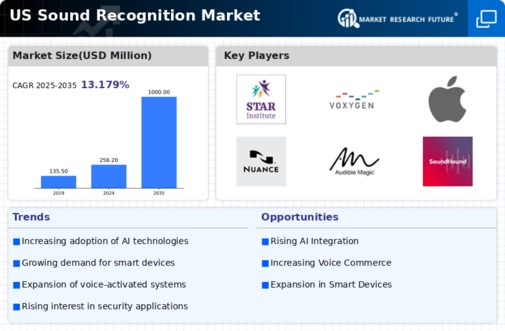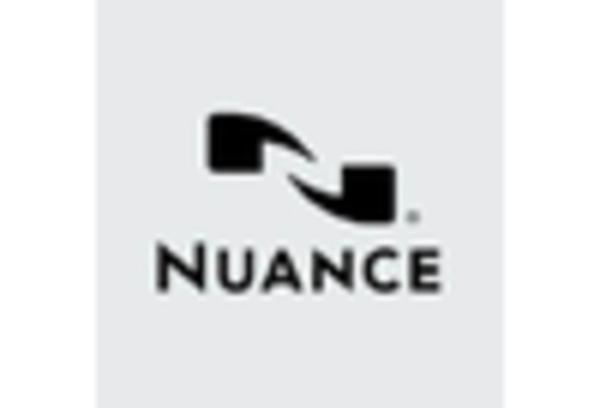Expansion of Healthcare Applications
is witnessing significant growth due to its expanding applications in the healthcare sector. Technologies that utilize sound recognition are increasingly being employed for patient monitoring, diagnostics, and even therapeutic interventions. For instance, sound recognition systems can analyze vocal patterns to detect early signs of conditions such as depression or respiratory issues. The healthcare industry is projected to invest over $200 billion in digital health technologies by 2025, which includes sound recognition solutions. This investment indicates a strong belief in the potential of sound recognition to improve patient outcomes and streamline healthcare processes. As healthcare providers seek innovative ways to enhance patient care, the sound recognition market is poised to benefit from this trend.
Growing Need for Enhanced Security Solutions
is being propelled by an increasing need for enhanced security solutions across various sectors. Organizations are increasingly adopting sound recognition technologies for surveillance and threat detection, as these systems can identify unusual sounds or vocal patterns that may indicate security breaches. The sound recognition market is projected to reach $300 billion by 2026, with sound recognition playing a pivotal role in this growth. This trend suggests that businesses and institutions are prioritizing advanced technologies to safeguard their assets and personnel. As the demand for reliable security solutions continues to rise, the sound recognition market is likely to expand, offering innovative products that address these critical needs.
Rising Demand for Voice-Activated Technologies
The sound recognition market is experiencing a notable surge in demand for voice-activated technologies. This trend is largely driven by the increasing adoption of smart home devices, which utilize sound recognition to enhance user experience. According to recent data, the market for smart speakers alone is projected to reach approximately $10 billion by 2026, indicating a robust growth trajectory. As consumers become more accustomed to hands-free interactions, the sound recognition market is likely to expand further. This shift not only reflects changing consumer preferences but also highlights the potential for sound recognition technologies to integrate seamlessly into everyday life. Consequently, manufacturers are investing heavily in developing advanced sound recognition capabilities to meet this growing demand, thereby propelling the sound recognition market forward.
Increased Investment in AI and Machine Learning
The sound recognition market is significantly influenced by the rising investment in artificial intelligence (AI) and machine learning technologies. These advancements enable more accurate and efficient sound recognition systems, which are essential for various applications, including customer service automation and security systems. In 2025, the AI market is expected to surpass $190 billion, with a substantial portion allocated to sound recognition technologies. This influx of capital is likely to accelerate innovation and development within the sound recognition market, leading to more sophisticated solutions that can understand and process human speech with greater precision. As businesses recognize the value of integrating AI-driven sound recognition into their operations, the market is expected to experience robust growth.
Integration of Sound Recognition in Automotive Systems
The sound recognition market is experiencing growth due to its integration into automotive systems, enhancing user experience and safety. Modern vehicles increasingly incorporate sound recognition technologies for voice commands, enabling drivers to control navigation, music, and communication systems without distraction. The automotive industry is projected to invest over $50 billion in connected car technologies by 2025, which includes sound recognition capabilities. This investment reflects a commitment to improving driver safety and convenience through innovative technologies. As consumers demand more intuitive and hands-free solutions in their vehicles, the sound recognition market is likely to benefit from this trend, leading to further advancements in automotive sound recognition applications.
















Leave a Comment